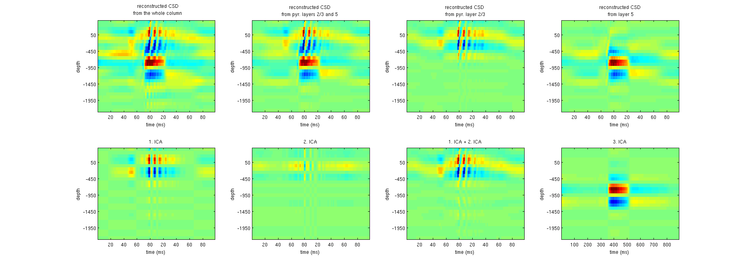Independent components of reconstructed current sources reflect activity of individual cell populations
Filed under:
Computational neuroscience
Helena Głąbska (Department of Neurophysiology, Nencki Institute), Jan Potworowski (Department of Neurophysiology, Nencki Institute), Szymon Łęski (Department of Neurophysiology, Nencki Institute), Daniel Wójcik (Department of Neurophysiology, Nencki Institute)
Local field potential (LFP) – the low-frequency part of the potential recorded extracellularly in the brain – reflects neural activity at the population level. The interpretation of LFP is complicated because it can mix activity from remote cells, on the order of millimeters from the electrode. To understand better the connection between the recordings and the local cell activity we expanded the thalamocortical model of Traub et al. (2005)[1] to compute simultaneous LFP [2], transmembrane currents and spiking activity.
We used this model to study the information contained in independent components obtained from the reconstructed Current Source Density (CSD) [3], which smooths transmembrane currents, decomposed with Independent Component Analysis (ICA) [4]. We found out that three components obtained reliably matched well the activity of two dominating cell populations: superior pyramidal cells in layer 2/3 (rhythmic spiking) and tufted pyramids from layer 5 (intrinsically bursting). Interestingly, the pyramidal population from layer 2/3 could not be well described as a product of spatial profile and temporal activation, but was matched well by a sum of two such products which we recovered in two of the ICA components in our analysis, which seem to reflect different inputs on dendritic trees within the population.
Research supported by grants 5428/B/P01/2010/39, POIG.02.03.00-00-003/09, POIG.02.03.00-00-018/08.
1. Traub RD, Contreras D, Cunningham MO, Murray H, LeBeau FEN, Roopun A, Bibbig A, Wilent WB, Higley MJ, Whittington MA: Single-Column Thalamocortical Network Model Exhibiting Gamma Oscillations, Sleep Spindles, and Epileptogenic Bursts. J Neurophysiol 2005, 93:2194-2232.
2.Holt GR, Koch C. Electrical interactions via the extracellular potential near cell bodies. J Comput Neurosci. 1999; 6:169‐184.
3.Potworowski J, Jakuczun W, Łęski S, Wójcik DK: Kernel current source density method. Neural Comput 2012, 24:541–575.
4. Łęski S, Kublik E, Świejkowski DA, Wróbel A, Wójcik DK: Extracting functional components of neural dynamics with Independent Component Analysis and inverse Current Source Density. J Comput Neurosci 2010, 29:459–473.
We used this model to study the information contained in independent components obtained from the reconstructed Current Source Density (CSD) [3], which smooths transmembrane currents, decomposed with Independent Component Analysis (ICA) [4]. We found out that three components obtained reliably matched well the activity of two dominating cell populations: superior pyramidal cells in layer 2/3 (rhythmic spiking) and tufted pyramids from layer 5 (intrinsically bursting). Interestingly, the pyramidal population from layer 2/3 could not be well described as a product of spatial profile and temporal activation, but was matched well by a sum of two such products which we recovered in two of the ICA components in our analysis, which seem to reflect different inputs on dendritic trees within the population.
Research supported by grants 5428/B/P01/2010/39, POIG.02.03.00-00-003/09, POIG.02.03.00-00-018/08.
1. Traub RD, Contreras D, Cunningham MO, Murray H, LeBeau FEN, Roopun A, Bibbig A, Wilent WB, Higley MJ, Whittington MA: Single-Column Thalamocortical Network Model Exhibiting Gamma Oscillations, Sleep Spindles, and Epileptogenic Bursts. J Neurophysiol 2005, 93:2194-2232.
2.Holt GR, Koch C. Electrical interactions via the extracellular potential near cell bodies. J Comput Neurosci. 1999; 6:169‐184.
3.Potworowski J, Jakuczun W, Łęski S, Wójcik DK: Kernel current source density method. Neural Comput 2012, 24:541–575.
4. Łęski S, Kublik E, Świejkowski DA, Wróbel A, Wójcik DK: Extracting functional components of neural dynamics with Independent Component Analysis and inverse Current Source Density. J Comput Neurosci 2010, 29:459–473.

Preferred presentation format:
Poster
Topic:
Computational neuroscience

 Latest news for Neuroinformatics 2011
Latest news for Neuroinformatics 2011 Follow INCF on Twitter
Follow INCF on Twitter
